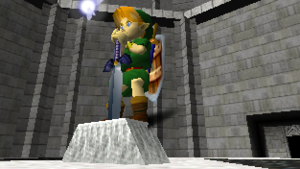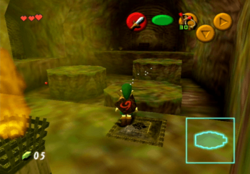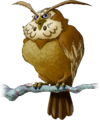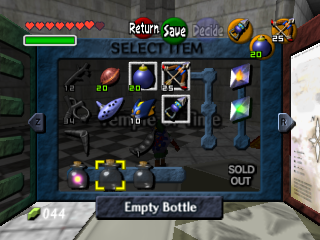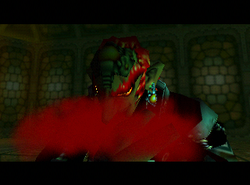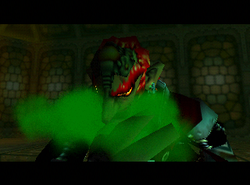| Don't like the ads? Then create an account! Users with accounts have more options than anonymous users. |
The Legend of Zelda: Ocarina of Time
It has been requested that this article be rewritten and expanded to add item descriptions and a Reception section.
| The Legend of Zelda: Ocarina of Time | |||||||
|---|---|---|---|---|---|---|---|

| |||||||
| Developer(s) | Nintendo EAD | ||||||
| Publisher(s) | Nintendo | ||||||
| Release date | Nintendo 64: Players Choice: iQue Player: Virtual Console (Wii): Virtual Console (Wii U): | ||||||
| Genre(s) | Action-adventure | ||||||
| Rating(s) |
| ||||||
| Console(s) | Nintendo 64, Nintendo GameCube, iQue Player, Virtual Console (Wii, Wii U) | ||||||
| Mode(s) | Single player | ||||||
- This article is about the game itself. For the eponymous GameCube compilation featuring the original game and Master Quest, see The Legend of Zelda: Ocarina of Time (Nintendo GameCube).
The Legend of Zelda: Ocarina of Time is the fifth installment of The Legend of Zelda series, and it was released on the Nintendo 64 in late 1998. It is the first title of the series to feature 3D graphics. In 2000, a direct sequel was released, The Legend of Zelda: Majora's Mask.
Prior to its release, The Legend of Zelda: Ocarina of Time was one of the most highly anticipated games of its time. Upon its release, the game won numerous awards, and many publications placed it on lists of the greatest video games of all time. The Legend of Zelda: Ocarina of Time was released on a 32-megabyte cartridge, which was the largest capacity Nintendo had produced at that time. The game introduced the target-lock system and context-sensitive buttons, which have appeared in subsequent 3D installments of The Legend of Zelda series. The gameplay of The Legend of Zelda: Ocarina of Time would inspire and be reused in several video games, including a first-party game, Star Fox Adventures.
The Legend of Zelda: Ocarina of Time has been ported a few times. The first time was on an eponymous compilation for the Nintendo GameCube, where the player can play the original game or the newly-added Master Quest mode. In 2011, a remake of the game was released on Nintendo 3DS, titled The Legend of Zelda: Ocarina of Time 3D.
Story
The game is introduced by the Great Deku Tree, who tells that every Kokiri of the Kokiri Forest have their own fairy, except for Link. Link has a nightmare of a young girl fleeing on a horse from a man in black armor. The Great Deku Tree is nearing death, and he assigns Navi to be Link's guardian fairy, and also requests her to bring Link over. Navi wakes Link from his nightmare and directs him to meet the Great Deku Tree.
After equipping with a sword and a shield, Link and Navi go to meet The Great Deku Tree. The tree tells them that he was cursed by a "wicked man of the desert", who seeks to conquer the world, and that Link is the chosen one to stop him. The Great Deku Tree provides a test of courage to Link to enter inside him. After Link defeats the Gohma within the Great Deku Tree, he rewards Link with the Kokiri's Emerald, the Spiritual Stone of the forest, and instructs him to visit Hyrule Castle to speak with the princess of Hyrule. Just after providing this instruction, the Great Deku Tree dies.
Link leaves Kokiri Forest and goes all the way through Castle Town and to the Hyrule Castle, where he sneaks past some soldiers to meet with Princess Zelda in the Castle Courtyard. She explains about her dream of Link and his guardian fairy, Navi, bearing the Kokiri's Emerald and slashing through the darkness. She points out the evil Ganondorf, whom she believes was represented by the darkness in her dream, and that he is seeking to steal the Triforce from the Sacred Realm. Zelda instructs Link to retrieve the other Spiritual Stones so that he can enter the Sacred Realm and claim the Triforce before Ganondorf.
Link sets off to both Death Mountain and Zora's Domain, where he successfully assists both the Gorons and the Zoras against Ganondorf's forces in their pursuit of the two other Spiritual Stones. Darunia, the leader of the Gorons, rewards link with the Goron's Ruby while Ruto, the princess of the Zoras, rewards Link with the Zora's Sapphire.
Link returns outside of Hyrule Castle, where he witnesses the same events as in his nightmare: Zelda and Impa are fleeing on horseback from Ganondorf, who attempts to steal the Ocarina of Time from them. Zelda quickly throws the Ocarina of Time into the moat for Link to obtain. When he obtains the ocarina, Link receives a telepathic message from Zelda, who teaches him the Song of Time and instructs him to play it at the altar of the Temple of Time.
At the Temple of Time, Link opens the Door of Time by playing the Song of Time and using the three Spiritual Stones. There, he finds the Master Sword in the Pedestal of Time and draws it, unlocking the Sacred Realm. Link successfully wields the sword, although he remains trapped in the Sacred Realm. Ganondorf sneaks into the Sacred Realm, believing that Link had the means necessary for entering the Sacred Realm. Link helplessly watches Ganondorf entering the Sacred Realm and obtaining the Triforce.
Seven years later, Link is awakened in the Chamber of Sages by an old man named Rauru. He reveals that Link is the Hero of Time, who is the person that can pull the Master Sword from its pedestal. He also explains that Link's spirit was locked away in the Sacred Realm because he was too young to be the Hero of Time and defeat Ganondorf. Rauru also tells Link that Ganondorf used the stolen Triforce to transform Hyrule into a land filled with darkness and monsters. He then instructs Link to find the other missing Sages, who have the collective power to trap Ganondorf within the Sacred Realm. However, five of the Sages are unaware of their identity as one, so Rauru grants Link with the Light Medallion and instructs him to find the other missing Sages.
Link returns into the Temple of Time, where he is greeted by Sheik, a survivor of the Sheikah tribe. He further guides Link by instructing him to free five temples from Ganondorf's control and allow each temple's Sage to awaken. Link had befriended the five other Sages during his childhood: Saria, the Sage of the Forest, Darunia, the Sage of Fire, Ruto, the Sage of Water, Nabooru, the Sage of Spirit, and Impa, the Sage of Shadow.
After awakening every Sage, Link returns to the Temple of Time, where Sheik tells another legend of the Triforce, explaining that it to be a fusion of three triangles that represent the three virtues governed by the three goddesses: Power, Wisdom, and Courage. If the person holding the Triforce has a balance of these virtues, then they can obtain the Triforce intact. However, if that person does not have a balance of those virtues, then the Triforce splits into three pieces, and the owner only keeps the piece of whichever virtue they most strongly believe in. The prophecy is a reference to Ganondorf's case, where his strongest belief was in power, and therefore he lost the other two parts of the Triforce. The legend further states that the person must strive to acquire the two missing parts, each one being safeguarded by a person with the crest of the goddesses on the back of their hands.
Ganondorf had managed to conquer the Sacred Realm, but felt that his acquisition of power was not enough. Ganondorf, wanting complete control over the world, started a search for the two missing pieces of the Triforce. Sheik reveals that Link holds the Triforce of Courage, just before taking off his own disguise, revealing himself as Princess Zelda. She reveals herself to be the seventh Sage and the safeguarder of the Triforce of Wisdom. However, by exposing herself to Link, Ganondorf finds out, and he traps her within a large crystal and retreats with her into his Castle.
Link rushes outside of Ganon's Castle (where Hyrule Castle had originally stood). With help from the six other Sages, Link manages to travel through the castle. Link eventually enters a room with Ganondorf and Zelda, where he engages in a battle against Ganondorf. After their first battle, Link frees Zelda from her crystal. Ganondorf destroys the Castle in an attempt to kill both Link and Zelda, who manage to quickly escape from it.
Ganondorf emerges from the castle's rubble, and with the Triforce of Power, he transforms into a beast named Ganon. Just before the second battle, Ganon knocks the Master Sword out of Link's hands, and encloses both of them within a forcefield, preventing Link from retrieving the Master Sword. However, with Zelda's help, Link manages to retrieve Master Sword, which he ultimately uses to destroy Ganon. With their restored powers, the seven Sages banish Ganondorf into the Dark Realm. Since Ganondorf still has the Triforce of Power, Ganondorf vows to get revenge on their descendants.
Zelda instructs Link to return the Master Sword in its pedestal, closing the path between the two timelines. She then plays the Song of Time and returns Link back into his childhood. Link still retains the knowledge of the entire incident, and revisits Princess Zelda in the Castle Courtyard, informing her of the whole incident to prevent it from happening again.
Gameplay
The Legend of Zelda: Ocarina of Time is set within an expansive 3D environment where the player moves Link around. Like The Legend of Zelda, the game introduced a few mechanics that were reused in subsequent games of its type; in Ocarina of Time's case, it is context-sensitive actions and targeting. Much of the gameplay was later reused in the sequel, The Legend of Zelda: Majora's Mask.
With context-sensitive actions, this allows for numerous actions to be assigned to one button, which varies based on Link's location and action in the game. For example, if Link draws out his sword, the HUD display instructs the player to holster it by pressing A. Another example is if Link is standing at a door, causing the HUD's A button to read "Open", which directly instructs the player to press the button to open the door. Targeting causes the camera to directly focus on an object or enemy. During this mode, when the player presses a button, Link automatically performs the corresponding action (such as striking his sword) on the target without the player having to move the Control Stick.
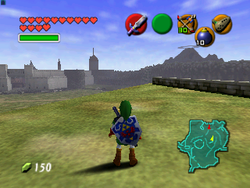
The player controls Link as an adult or a child in different parts of his adventure. From the Door of Time, when Link pulls the Master Sword, he travels seven years in the future and becomes an adult. Link has different abilities as both a child and an adult, both of which are key to solving puzzles. For example, Link can only use the Fairy Bow as an adult, while only young Link can crawl through small passages.
Like previous The Legend of Zelda installments, Link's main weapon is a sword and shield. As a child, Link can obtain more basic weapons, such as Bombs and Deku Seeds, within the dungeons or from different locations. As an adult, Link can still obtain most of the basic weapons (which does not include Deku Seeds). As an adult, Link can obtain two additional tunics and boots, aside from the default Kokiri Tunic and Kokiri Boots; the player can switch Link's tunic and boots from the Equipment subscreen of the Inventory. The tunics include the Goron Tunic and Zora Tunic, which respectively allow Link to withstand hot, volcanic climate and to breathe underwater, and the boots include the Iron Boots and Hover Boots which respectively allow him to sink to the bottom of water and to temporarily hover in midair.
There are side quests during Link's adventure, and they are optional but often involve a reward at the end, such as the Biggoron's Sword or the ability to ride Epona, allowing Link to navigate around Hyrule Field faster.
Just as Link exits from Kokiri Forest, Saria provides him with the Fairy Ocarina, later replaced with the titular Ocarina of Time. Throughout the game, Link learns twelve melodies that allow him to solve music-based puzzles and to teleport back to specific location that he has already visited.
Characters
Heroes
Races
The Legend of Zelda: Ocarina of Time is the first game of the series with a variety of different races. There are six different races, each located in a different area of the game. They include the Hylians, the Kokiri, the Gorons, the Zoras, the Sheikah, and the Gerudo.
- The Hylians are similar to humans, except for their pointed, elf-like ears. Most of them like Castle Town, though some live in nearby Kakariko Village and others are scattered sporadically throughout Hyrule. They are ruled by a king, whose daughter is Princess Zelda.
- The Kokiri are forest children who were created by the guardian spirit of Kokiri Forest, the Great Deku Tree. They never age and can never leave the forest. Link, the hero of the game, lives among them at the start of the game. His closest friend is a Kokiri named Saria. Link is not a true Kokiri but a Hylian, orphaned in the forest as a baby, and raised by the Great Deku Tree, who sensed Link to be a child of destiny. The Kokiri are led by Mido.
- The Gorons are large, brown, rock-eating creatures that vary immensely in size and live in Goron City, halfway up Death Mountain, an active volcano. They are led by Darunia.
- The Zoras are blue fish-like creatures, who live at the top of Zora's River, the kingdom's source of water. The river runs all the way through Hyrule to Lake Hylia at the very opposite end of the kingdom. The Zoras are ruled by King Zora who has a daughter, Princess Ruto. The guardian spirit of Zora's Domain is Lord Jabu-Jabu.
- The Gerudo are an almost entirely female race of thieves who live in Gerudo Valley. Only one man is born within the race every century. According to tradition, that man is meant to be the king of the Gerudo race. Ganondorf is the most recent male of this race.
- The Sheikah, sworn "shadow guardians" of the royal family, appear to be Hylian with red eyes. They possess various magical abilities and are known to operate from within the shadows. Impa, Zelda's childhood nanny and bodyguard, is said to be the last remaining Sheikah. She helped establish Kakariko Village, at the base of Death Mountain.
Supporting characters
During Link's adventure, he encounters some supporting characters who directly assist him during his adventure.
Six sages
Not including Princess Zelda, the six Sages are the guardians of the Sacred Realm. Each Sage is from one of the six races.
Other characters
It has been requested that this section be rewritten. Reason: has conjectural, unsourced names; also needs reorganization, as some characters appear in the main quest while others only appear in sidequests
These are other, miscellaneous characters encountered by Link during his adventure. They act neither directly antagonistic nor supportive towards Link.
- Bazaar Owner
- Bean Seller
- Biggoron
- Bombchu Shop Owner
- Bombchu Bowling Alley Operator
- Bonooru
- Buyer
- Carpenters
- Carpet Merchant
- Cucco Lady
- Cursed Rich Man
- Dampé
- Dancing Couple
- Death Mountain Trail Gatekeeper
- Deku Tree Sprout
- Fabulous Five Froggish Tenors
- Fado
- Fishing Hole Man
- Granny
- Graveyard Boy
- Happy Mask Salesman
- Hot Rodder Goron
- Ingo
- King Zora
- Know-It-All Brothers
- Lake Scientist
- Link (Goron)
- Lord Jabu-Jabu
- Mamamu Yan
- Master Craftsman's Son
- Medicine Shop Owner
- Medigoron
- Mido
- Phonograph Man
- Poe Collector
- Professor Shikashi
- Running Man
- Shooting Gallery Owner
- Skull Kid
- Soldiers
- Treasure Chest Shop Owner
- Twin Jugglers
Locations
Main locations
- Death Mountain
- Ganon's Castle
- Gerudo Valley
- Hyrule Castle
- Hyrule Castle Town
- Hyrule Field
- Kakariko Village
- Kokiri Forest
- Lake Hylia
- Lon Lon Ranch
- Lost Woods
- Temple of Time
- Zora's Domain
Dungeons
| Name | Description |
|---|---|
| Inside the Deku Tree | The first dungeon in the game has Link traveling through the Great Deku Tree in an attempt to break a curse that Ganondorf placed on him. The first Spiritual Stone, the Kokiri's Emerald, is the reward for completing the dungeon. |
| Dodongo's Cavern | This area is the main source of food for the Gorons. The area was invaded by Dodongos during the game, and Link must go in to dispatch of them. The second Spiritual Stone, the Goron's Ruby, is the reward for completing the dungeon. |
| Inside Jabu-Jabu's Belly | The third dungeon takes place in Jabu-Jabu's belly, and Link must go in to rescue Princess Ruto. The third and final Spiritual Stone, the Zora's Sapphire, is the reward for completing the dungeon. |
| Forest Temple | The Forest Temple is the first dungeon that Link explores as an adult and the fourth dungeon overall. One of its distinct rooms is a long, twisted hallway. Completing the dungeon awakens the first Sage, Saria. |
| Fire Temple | In the Fire Temple, Link has to rescue all of the Gorons, who were captured by Ganondorf and planned to be fed to Volvagia for not complying to his requests. By completing the dungeon, Link saves the Gorons and awakens the second Sage, Darunia. |
| Water Temple | In the Water Temple, Link has to solve a variety of puzzles both in water and on land. Completing the temple awakens the third Sage, Ruto. |
| Spirit Temple | For the penultimate dungeon, Link must first explore it as a child, then as an adult. Completing the temple awakens the sixth Sage, Nabooru. |
| Shadow Temple | In the temple, Link has to travel through a labyrinth of hidden areas, where he encounters several undead and paranormal enemies. Completing the Shadow Temple awakens the fourth Sage, Impa. |
| Inside Ganon's Castle Ganon's Tower |
The final dungeon takes place in Ganon's Castle, which features several mid-boss battles and eventually one against Ganondorf himself. |
Minor dungeons
Enemies
- Anubis
- Armos
- Baby Dodongo
- Bari
- Beamos
- Big Deku Baba
- Big Poe
- Big Skulltula
- Biri
- Bubble (blue, green, red, and white)
- Business Scrub
- Deku Baba
- Deku Scrub
- Dinolfos
- Dodongo
- Fire Keese
- Floormaster
- Freezzard
- Gerudo guard
- Gibdo
- Gohma Larva
- Gold Skulltula
- Guay
- Ice Keese
- Iron Knuckle
- Keese
- Leever
- Like Like
- Lizalfos
- Mad Scrub
- Moblin (spear)
- Moblin (club)
- Octorok
- Parasitic Tentacle
- Peahat Larva
- Peahat
- Poe (normal and Hyrule Field types)
- Poe of the Graveyard (Sharp the Elder and Flat the Younger)
- Poe Sisters (Amy, Joelle, and Beth)
- ReDead
- Shabom
- Shell Blade
- Skulltula
- Skullwalltula
- Stalchild
- Stalfos
- Stinger
- Tailpasaran
- Tektite (Red and blue)
- Torch Slug
- Wallmaster
- Wolfos (normal and white)
Obstacles
- Boulder
- Brob
- Door Mimic
- Falling rock
- Fire Barrier
- Fire Eye
- Floor Spikes
- Flying Pot
- Flying Tile
- Scythe
- Trap
Minibosses
- Lizalfos (Dodongo's Cavern)
- Bigocto (Inside Jabu-Jabu's Belly)
- Stalfos (Forest Temple)
- Meg of the Poe Sisters (Forest Temple)
- Dead Hand (Bottom of the Well, Shadow Temple)
- Flare Dancer (Fire Temple)
- White Wolfos (Ice Cavern)
- Dark Link (Water Temple)
- Gerudo Thief (Thieves' Hideout)
- Iron Knuckle (Spirit Temple)
Bosses
| Image | Name | Dungeon |
|---|---|---|

|
Parasitic Armored Arachnid: Gohma | Inside the Deku Tree |

|
Infernal Dinosaur: King Dodongo | Dodongo's Cavern |

|
Bio-Electric Anemone: Barinade | Inside Jabu-Jabu's Belly |

|
Evil Spirit from Beyond: Phantom Ganon | Forest Temple |

|
Subterranean Lava Dragon: Volvagia | Fire Temple |

|
Giant Aquatic Amoeba: Morpha | Water Temple |
 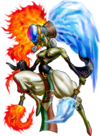
|
Sorceress Sisters: Twinrova (Koume and Kotake) | Spirit Temple |

|
Phantom Shadow Beast: Bongo Bongo | Shadow Temple |

|
Great King of Evil: Ganondorf | Ganon's Tower |
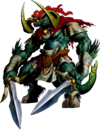
|
Ganon | Ganon's Castle |
Items
 This section is a stub. You can help Triforce Wiki by expanding it.
This section is a stub. You can help Triforce Wiki by expanding it.
The items and weapons that Link uses often depends on whether he is a child or an adult. The player can assign items to either ![]() ,
, ![]() , and
, and ![]() from the Select Item Subscreen.
from the Select Item Subscreen.
There are some items that Link can only obtain once.
| Icon | Name | Child/Adult Timeline? | Description |
|---|---|---|---|
| Fairy Ocarina | Child | ||
| Gerudo's Membership Card | Adult | ||
| Letter in a Bottle | Child | ||
| Ocarina of Time | Both | ||
| Stone of Agony | Both | ||
| Weird Egg / Cucco | Child | ||
| Zelda's Letter | Child |
There are some items that Link obtains more than once during his adventure, many of which reappear from previous The Legend of Zelda installments. All of these items are accessible to Link as either a child or an adult except the Magic Beans, which he can only obtain as a child.
| Icon | Name | Description |
|---|---|---|
| Empty Bottle | ||
| Gold Skulltula Token | ||
| Heart | ||
| Heart Container | ||
| Magic Bean | ||
| Magic Jar | ||
| Piece of Heart | ||
| Rupee |
There are a few items that reappear only in dungeons. While child Link can obtain Small Keys during the Treasure Chest Shop minigame, the keys start appearing in dungeons when Link is an adult.
| Icon | Name | Description |
|---|---|---|
| Boss Key | These are one-time use items that unlock the boss room of a dungeon. Link can always obtain a Boss Key by defeating the second mini-boss of a dungeon. | |
| Compass | These allow Link to see where treasure chests are located in a dungeon. They also show the direction Link is facing and where he entered the room. | |
| Dungeon Map | These show which rooms Link has visited and which room he is currently in. When paired with a Compass, a Dungeon Map shows which rooms have treasure chests, which rooms have not yet been visited, and the dungeon boss's room. | |
| Small Key | One-time use items that unlock certain regular doors within dungeons. They are usually found within treasure chests. |
There are some items that Link cannot obtain unless he has a bottle to store it in. Every bottled item is usable in both timelines.
| Icon | Name | Description |
|---|---|---|
| Blue Fire | ||
| Blue Potion | ||
| Bug | ||
| Fairy | ||
| Fish | ||
| Green Potion | ||
| Milk | ||
| Poe Soul / Big Poe Soul | ||
| Red Potion |
Weapons
There are a couple of weapons that Link obtains only once.
| Icon | Name | Child/Adult Timeline? | Description |
|---|---|---|---|
| Boomerang | Child | ||
| Fairy Bow | Adult | ||
| Fairy Slingshot | Child | ||
| Hookshot | Adult | ||
| Lens of Truth | Both | ||
| Longshot | Adult | ||
| Megaton Hammer | Adult |
There are some weapons that Link can carry more than one of.
| Icon | Name | Child/Adult Timeline? | Description |
|---|---|---|---|
| Bomb | Both | ||
| Bombchu | Both | ||
| Deku Nut | Both | ||
| Deku Seed | Child | ||
| Deku Stick | Child | ||
| Fire Arrow | Adult | ||
| Ice Arrow | Adult | ||
| Light Arrow | Adult |
Link can acquire three new abilities from a spell, each provided by one of the Great Fairies. Every spell is named after one of the three goddesses.
| Icon | Name | Description |
|---|---|---|
| Din's Fire | ||
| Farore's Wind | ||
| Nayru's Love |
Equipment
The equipment is organized horizontally on a separate menu, the Equipment Subscreen. If Link has more than one type of sword, shield, tunic, or boots, the player can switch between them.
| Icon | Name | Child/Adult Timeline? | Description |
|---|---|---|---|
| Swords | |||
| Kokiri Sword | Child | ||
| Master Sword | Adult | ||
| Biggoron's Sword | Adult | ||
| Giant's Knife | Adult | ||
| Shields | |||
| Deku Shield | Child | ||
| Hylian Shield | Both | ||
| Mirror Shield | Adult | ||
| Tunics | |||
| Kokiri Tunic | Both | ||
| Goron Tunic | Adult | ||
| Zora Tunic | Adult | ||
| Boots | |||
| Kokiri Boots | Both | ||
| Iron Boots | Adult | ||
| Hover Boots | Adult | ||
There is some equipment that Link can upgrade later on in his adventure. Each type is displayed from the leftmost side of the Inventory.
| Icon | Name | Child/Adult Timeline? | Description |
|---|---|---|---|
| Deku Seed Bullet Bags | |||
| Deku Seed Bullet Bag | Child | ||
| Big Deku Seed Bullet Bag | Child | ||
| Biggest Deku Seed Bullet Bag | Child | ||
| Quivers | |||
| Quiver | Adult | ||
| Big Quiver | Adult | ||
| Biggest Quiver | Adult | ||
| Bomb Bags | |||
| Bomb Bag | Both | ||
| Big Bomb Bag | Both | ||
| Biggest Bomb Bag | Both | ||
| Gauntlets | |||
| Goron's Bracelet | Child | ||
| Silver Gauntlets | Adult | ||
| Golden Gauntlets | Adult | ||
| Scales | |||
| Silver Scale | Both | ||
| Golden Scale | Both | ||
Link starts out with a Wallet that holds up to 99 Rupees. There are two Wallet upgrades that he can acquire during his adventure, and these can hold a higher capacity of rupees. Unlike the other equipment, the Wallets do not have icons that are displayed on inventory; their icon is only shown when Link in the dialogue box for when Link obtains the wallet. Both wallets can be used in either the child or the adult timeline.
| Icon | Name | Description |
|---|---|---|
| Adult's Wallet | ||
| Giant's Wallet |
Spiritual Stones
As a child, Link must obtain three Spiritual Stones in order to open the Door of Time at the Temple of Time. The obtained stones are displayed from the Inventory's "Quest Status" subscreen.
Medallions
As an adult, Link must obtain six Medallions, each corresponding to one of the Sages. They are a source of the Sages' power, which they use to help Link enter into Ganon's Castle. Link's collected Medallions are displayed from the Inventory's "Quest Status" subscreen.
Masks
There are seven masks that Link can wear as a child. They are optional and most do not have any purpose aside from others reacting differently when seeing Link. A few of these masks would later play a major role in The Legend of Zelda: Majora's Mask.
Item trading sequence
As an adult, Link can participate in a trading sequence where he must trade ten items, each to a different character, until finally receiving the Biggoron's Sword.
Development
The Legend of Zelda: Ocarina of Time was first presented as a technical and thematic demonstration video at Nintendo's Shoshinkai trade show in December 1995. Similar to the first The Legend of Zelda, the game was concurrently developed by Nintendo EAD with another Super Mario title, in this case, Super Mario 64.
Nintendo's original plan was to release The Legend of Zelda: Ocarina of Time as a flagship title for the Nintendo 64DD peripheral.[1] However, at some point during its early development, Nintendo decided to migrate The Legend of Zelda: Ocarina of Time from disk to cartridge media and follow its release with a 64DD expansion disk.[2]
The Legend of Zelda: Ocarina of Time was eventually released on a 32-megabyte cartridge. At the time, it was the largest game that Nintendo had ever created.[3] Early in development, the developers were concerned about the cartridge's data storage constraints; in the worst-case scenario, The Legend of Zelda: Ocarina of Time would follow a similar structure to Super Mario 64, with Link restricted to Ganon's Castle as a central hub and using a portal system similar to the paintings from Super Mario 64. The Forest Temple boss, Phantom Ganon, was an idea carried over during that point in development, as shown from him riding on a horse through the paintings.[4]
Shigeru Miyamoto was a producer and supervisor behind The Legend of Zelda: Ocarina of Time and was in charge of several directors.[5] The game was handled by multiple directors, a newly adopted strategy by Nintendo EAD at the time. The four or five initial teams grew in number over time, each working on the various aspects of the game.[6]
Miyamoto intended the game, a "medieval tale of sword and sorcery", to be in the chanbara genre of Japanese sword fighting. More than 120 people were involved in the game's development, including stunt performers for capturing the effects of sword fighting and Link's movement.[7] Miyamoto initially intended The Legend of Zelda: Ocarina of Time to be played in a first-person perspective to enable players to better take in the vast terrain of Hyrule Field and allow the team to more easily focus on developing enemies and environments. The concept was abandoned once the idea of a child Link was introduced, and Miyamoto believed it was necessary for Link to have on-screen visibility.[8]
The Legend of Zelda: Ocarina of Time originally ran on the same engine as Super Mario 64, but was so heavily modified that Miyamoto considers both games to have entirely different engines.[9] A major difference with The Legend of Zelda: Ocarina of Time's modified engine is camera control, which is automatically controlled by the game. Miyamoto explained that the camera controls are intended to reflect a focus on the game's world, contrary to Super Mario 64's, which are centered around Mario.[10]
With The Legend of Zelda: Ocarina of Time, Miyamoto wanted to create a game that was cinematic, yet distinguished from films. Takumi Kawagoe, who creates cutscenes for Nintendo, said that he intended to give players the feeling that they were in control of the action.[11] The cutscenes were originally created using prerendered images, and a few months before the game's completion, Miyamoto decided that the cinematics should have real-time processing. His vision required the real-time architecture for the total of more than 90 minutes of cutscenes, regardless of whether the console had a vast medium like CD-ROM on which to store prerendered versions. Miyamoto stated the real-time rendering engine allowed his small team of 3 to 7 cinematic developers to rapidly adjust the storyline and to focus on developing additional gameplay elements even up to the final few months of development, instead of waiting on a repeated prerendering process.[10]
Anticipation and release
In March 1998, The Legend of Zelda: Ocarina of Time was the most anticipated Nintendo 64 game in Japan.[12] Throughout the late 1990s, people believed that the Nintendo 64 was critically lacking in first-party hit releases. The August 1998 issue of Next Generation magazine stated that "Nintendo absolutely can't afford another holiday season without a real marquee title" and that Zelda was "one of the most anticipated games of the decade", upon which the Nintendo 64's fate depended. At E3 1998, Nintendo of America's chairman Howard Lincoln insisted that The Legend of Zelda: Ocarina of Time would be shipped on time and would become the company's reinvigorating blockbuster akin to a hit Hollywood movie.
The game had such high demand that Electronics Boutique stopped taking preorders on November 3, 1998.[13] Customers in North America who managed to pre-order the game received a limited edition box with a golden plastic card affixed, reading "Collector's Edition". This edition contained a gold-colored cartridge, which the first two The Legend of Zelda titles on the Nintendo Entertainment System had.
In the United States alone, over 500,000 preorders were placed, more than tripling the number of preorders for any previous games, and more than a million copies were sold in the country in less than a week.[14] By the end of 1998, 2.5 million copies of the game were sold, and Nintendo racked in about $150 million in revenue, higher than that of any Hollywood blockbuster films released around the same time.[15] In Japan, 820,000 copies were sold in 1998, becoming the tenth best-selling game of that year.[16] In the United Kingdom, 61,232 copies were sold during its first weekend.[14] During its lifetime, The Legend of Zelda: Ocarina of Time sold 1.14 million copies in Japan,[17] and 7.6 million copies worldwide.[18]
Ports
In 2002, the game was directly ported on the Nintendo GameCube with the same title, The Legend of Zelda: Ocarina of Time. The GameCube version featured the original game and the newly-included Master Quest mode.
In 2003, The Legend of Zelda: Ocarina of Time was included as one of the four playable The Legend of Zelda games on the compilation, The Legend of Zelda: Collector's Edition. That same year, The Legend of Zelda: Ocarina of Time was released as a launch title for the iQue Player. Many years later, it was discovered that a traditional Chinese version was under development for the iQue Player in 2006 (as evidenced from the title screen), but this was ultimately cancelled for unknown reasons.[19]
In February 2007, The Legend of Zelda: Ocarina of Time was released on the Wii's Virtual Console, priced at 1,000 Wii Points. A five-minute demo of the game can be unlocked in Super Smash Bros. Brawl. In 2015, the game was ported to the Wii U's Virtual Console, and it restored the original controller vibrations absent from the Wii Virtual Console version.
Version differences
The Legend of Zelda: Ocarina of Time saw five revisions for its Nintendo 64 release, three in NTSC regions (Japan and North America) and two in PAL regions (Europe). The North American and and Japanese versions are almost identical except for a single byte which determines the language of the game (either English or Japanese). Each of the Nintendo 64 versions have a build date prior to the game's first release.[20]
The NTSC version 1.0 is the earliest retail version of the game. The Not For Resale versions are identical to NTSC's 1.0, and the gold cartridge releases are almost always a version 1.0, likely because they were provided to those who pre-ordered the game. NTSC 1.1 mainly fixed bugs and on-screen text issues, including minor grammatical fixes, and also changed the boot-up Nintendo 64 graphic to look glossier and less bright.
NTSC version 1.2 had some more noticeable changes. The PAL versions 1.0 and 1.1 are similar to this version.
- Ganondorf and Ganon's blood was changed from crimson to green, in one instance changing a spitting-up-blood animation into a simple vomiting one.
- Replacing the Fire Temple theme, which contained a sample of an Islamic prayer chant, with a remix of the Shadow Temple's theme. Contrary to popular belief, the chant was not removed in response to public outcry, but rather because Nintendo discovered that they violated their own policy to not include religious content in their games. The sample originated from a commercially available sound library, but the developers were unaware of its Islamic references.[21]
- A glitch where the player can drop Bombs down on Bongo-Bongo before the battle was fixed. This glitch caused Bongo-Bongo to be invisible throughout most of the battle.
- Some minor text changes and improvements were done to the dialogue.
The GameCube port of The Legend of Zelda: Ocarina of Time is based on NTSC 1.2 but with even some more changes, most noticeably regarding the GameCube controller.
- The game's internal resolution has doubled from 320x240 to 640x480.
- The crescent moon & star symbols that appear on dungeon blocks, Gerudo signs, and the Mirror Shield were changed to the Gerudo symbol from The Legend of Zelda: Majora's Mask. The reason for this change is most likely because it strongly resembles the symbol of Islam. This change was kept intact for all subsequent releases, including the Nintendo 3DS remake.
- The game has an improved framerate, and the crash debugger was removed.
- The controller icons and related text were changed to correspond to the GameCube controller. This caused the color of the B button in the Inventory to change from green to red and the A button to change from blue to green. The Nintendo 64's Z button was remapped to the GameCube's L button, and therefore Z-Targeting was renamed to "L-Targeting". These changes were not added into the iQue Player release and the Virtual Console ports.
Descriptions
Wii Shop Channel
- North America
"The Legend of Zelda: Ocarina of Time reveals the genesis of the fantasy land of Hyrule, the origin of the Triforce, and the tale of the first exploits of Princess Zelda and the heroic adventurer Link. Vibrant, real-time 3-D graphics transport you into the fantasy world of Hyrule. Your quest takes you through dense forests and across wind-whipped deserts. Swim raging rivers, climb treacherous mountains, dash on horseback across rolling hills, and delve into dungeons full of creatures that fight to the finish to put an end to your adventures. With immersive graphics, a sweeping story line, swashbuckling adventure, mind-bending puzzles, and a touch of humor, The Legend of Zelda: Ocarina of Time is one of Nintendo's most epic challenges ever."
- Europe
"Released to an eager audience in 1998, The Legend of Zelda: Ocarina of Time became an instant smash and quickly established itself as one of the greatest games ever made.
As the legendary hero Link, you must journey across Hyrule, and even through time itself, to thwart the plans of Ganondorf. You’ll wield weapons and gadgets galore, battle enormous bosses and solve brain-busting puzzles, which are among the best ever seen in the Zelda series.
Ocarina of Time brilliantly adapted the 2D, top-down style of classic Zelda adventures into 3D, becoming a textbook example of game design that is still followed today.
But the appeal of ‘Ocarina’ lies not only in its cinematic visuals or groundbreaking combat system; it also impresses with its epic storyline, memorable characters, superbly designed dungeons and rich variety of gameplay. Quite simply, it’s a masterpiece!"
Wii U Shop Channel
- North America
"The Legend of Zelda™: Ocarina of Time™—one of the most critically acclaimed games ever made—returns on Nintendo eShop for Wii U™. Set off on a legendary journey to stop Ganondorf, who has plunged Hyrule into darkness. Travel through time as child and adult Link™, and experience Hyrule in peace and war to save the world and protect the Triforce.
Your quest takes you through dense forests and across wind-whipped deserts. Swim raging rivers, climb treacherous mountains, dash on horseback across rolling hills, and delve into dungeons full of creatures that fight to the finish to put an end to your adventures. As Link, you’ll also travel through time to solve puzzles, save friends, and right Ganondorf’s wrongs with help from your trusty Ocarina of Time and the mysterious youth Sheik. The Legend of Zelda: Ocarina of Time is one of Nintendo's most epic challenges ever and one of its most touching stories. It is an absolute must-play for Nintendo fans."
- Europe
"Join legendary hero Link as he journeys across Hyrule, and even through time, to thwart the plans of Ganondorf. Wield incredible weapons and items, battle ferocious bosses, and solve brain-teasing puzzles, in this acclaimed chapter of the Zelda series.
Whether you’re experiencing it for the first time or not, the original Nintendo 64 version is a treasure of gaming history; introducing ground-breaking new 3D visuals, plus a highly influential combat system and a captivating story. The Legend of Zelda: Ocarina of Time is a masterpiece!"
Gallery
- Main article: Gallery:The Legend of Zelda: Ocarina of Time
Trivia
- The Legend of Zelda: Ocarina of Time is the last game in The Legend of Zelda series to have a cover with only the title logo on a beige background.
Names in other languages
| Language | Name | Meaning |
|---|---|---|
| Japanese | ゼルダの伝説 時のオカリナ Zeruda no Densetsu: Toki no Okarina |
|
| Chinese (Simplified) | 塞尔达传说:时光之笛 (logo) 塞尔达的传说 (internal name) Sàiěrdá Chuánshuō: Shíguāng zhī Dí (logo) ︎Sàiěrdá de Chuánshuō |
The Legend of Zelda: Ocarina of Time The Legend of Zelda |
| Chinese (Traditional) | 塞爾達傳說:時光之笛 (logo) 塞尔达传说:时光之笛 (internal name) Sàiěrdá Chuánshuō: Shíguāng zhī Dí |
The Legend of Zelda: Ocarina of Time |
External links
- Official website (Wayback Machine)
- Official Japanese website
- Official Chinese website
References
- ^ The Legend of Zelda: Ocarina of Time - GameSpot (Wayback Machine)
- ^ Zelda Officially Goes to Cart - IGN
- ^ Zelda 64 News: The biggest Cartridge Game Ever - IGN
- ^ Ocarina of Time Had Mario 64-Esque Paintings Early in Development - NintendoWorldReport
- ^ E3: Through the Eyes of Miyamoto Pt. 2 - IGN
- ^ GDC: Miyamoto Keynote Speech - IGN
- ^ Nintendo Power issue #111, August 1998
- ^ Why Are You Here? Shigeru Miyamoto And The Ocarina Of Time - Kotaku Australia (Wayback Machine)
- ^ Nintendo Power issue #114, November 1998
- ^ a b Sensei Speaks - IGN
- ^ Nintendo Power issue #198, December 2005 (pages 70–72)
- ^ What Japan Wants - IGN
- ^ Ye Snoozed, Ye Loozed - IGN
- ^ a b Computer and Video Games issue #207, February 1999
- ^ Zelda Breaks All Records - IGN
- ^ GEIMIN.NET - 1998年テレビゲームソフト売り上げTOP100
- ^ Game Ranking
- ^ GDC 2004: The History of Zelda
- ^ iQueBrew
- ^ Version Differences - Zelda Speedruns
- ^ Nintendo Officially Talks about the Infamous Ocarina of Time Fire Temple Chant - Zelda Dungeon


